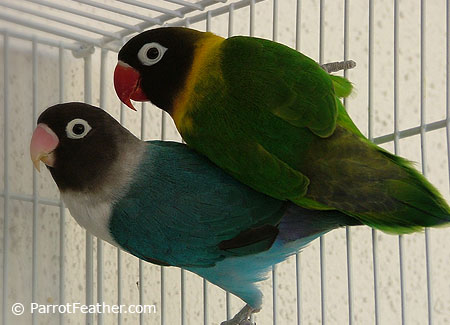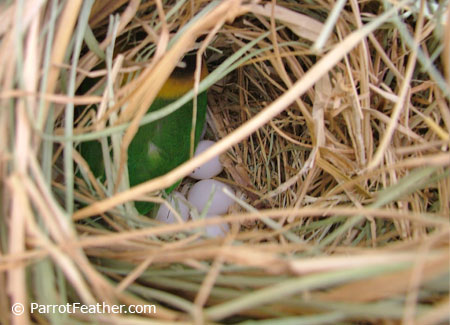Black-Masked LovebirdS
Common Names:
Green Masked Lovebirds, Black Masked Lovebird, Masked Lovebird, & Blue
Masked Lovebird.
Scientific Name:
Agapornis personata
Origin: Africa—
Tanzania
Relative Size: Small
50-56 grams
Average Lifespan: 10
– 20 years

General Information About Black-Masked Lovebirds
The Masked Lovebird is a favorite of many. This species can be
aggressive, but not to the extent of the Peach-Face Lovebird. These
birds are well-known for their black masks and bright colors. Masked
Lovebirds have a white ring around their eye, for this reason, they are
categorized into the eye ring group.
Masked Lovebirds come in quite a few mutations, considering they were
once difficult to obtain. The more popular of the mutations are the Blue
Masked Lovebird, followed by the standard Black Masked Lovebird. Many
breeders are working hard to produce more mutations; as a result, new
mutations should be available in the market very soon.
The Black Masked Lovebird has a bright green body with a black mask that
covers its head and gradually fades into the chest. Around the chest, a
small faded orange band also weakens into a yellow patch that covers the
breast. The lovebird’s tail is blue, green, and red. The beak is red,
making the lovebird look very striking.
The Blue Masked Lovebird is a mutation of the Black Masked Lovebird.
These birds look similar; however, blue is the prominent color. The
chest has a white patch that fades as it extends towards the stomach.
The tail is dark blue with hints of dark blue and white. The beak is
beige colored.
Sexing these lovebirds can be difficult because they are monomorphic,
which means males and females look identical or very similar. Some
breeders who have good eyes can sex visually. Most females are stockier
than males. Females have thicker feat and a wider space between their
pelvic bones. This is not an accurate way of sexing Masked Lovebirds.
The only reliable way would be though DNA sexing.
Breeding Masked Lovebirds

Breeding these birds is easy; and like most lovebirds, they require
humidity for a successful hatch. These birds enjoy shredding paper but
when it comes to nest building, they do not tuck material into their
wings. They carry material to their nesting site with their beaks.
The female lovebird will produce around 4 – 6 eggs and babies can be
expected 21-23 days later. If the eggs are unfertile, the female will
kick them out or cover them with new nesting material and proceed to
have more eggs.
During breeding season these birds should be fed a combination of seeds,
pellets, fruits, and vegetables. Giving the birds a healthy diet during
breeding will produce healthy babies.
If the babies are removed for hand feeding, they need to be removed
around ten days. Hand feeding will produce fantastic birds but time
needs to be set aside to interact with the babies. Socializing the
babies will make them confident and inquisitive. It is also a good idea
to start introducing fruits and vegetables into their diet at an early
age. This makes them less likely to have problems later when new foods
are introduced.




